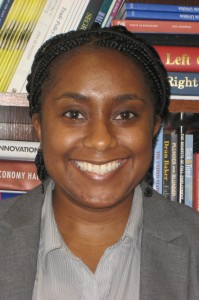I enjoy going to Comic-Con. The creative costumes and the variety of people in them, old and young, fat and thin, gender normative and gender queer, as well as the diversity of non-costumed attendees gleefully taking pictures with those in costumes make the event feel like a huge, four-day long Halloween. I also enjoy the coverage of shows and movies I love, the throng of people devoted to their love of “geeky” or “nerdy” stuff, the fact that the crowds are as diverse as the shows, texts, writers, and so on the Con features. In short, I am a fan of Comic-Con. That doesn’t mean I can’t also be critical of it. What am I critical of? Well, two things in particular. One, the fact that women are now at least 40% of the attendees but are not anywhere near 40% represented on panels or in Con content. And two, the misogynistic, prurient atmosphere that sometimes rears its drooling, leering head wherein (usually females) are objectified and/or harassed by others.
Regarding content, the panels themselves are still largely a “male domain.” This has not changed in the past three years I have attended. As in the media world generally, most directors, writers, producers and lead actors featured are male. And, even when there are females on the panels, males often dominate discussion. As a case in point, the Divergent panel.
Neil Burger (the director of the Divergent film) did most of the talking even when the moderator directed questions to the AUTHOR of the series, Veronica Roth. Burger was much like the dominator of the Doctor Who panel, Steven Moffat, who did the majority of the talking. Acting as if he had CREATED Doctor Who, Moffat said at one point, “the only way to write anything is to write for yourself.” An interesting claim while sitting in a hall filled with 6,500 fans who apparently don’t mean a thing as it’s all about YOU Steven. In contrast to the egotistical-sounding Moffat, Matt Smith and Jenna Coleman were very personable and funny and THANKED the fans.
A nice variance to these white male dominators was Alfonso Cuaron, director of the upcoming Gravity, starring Sandra Bullock, who defended his choice of casting a female lead and noted his dismay that such defenses are still necessary (for a post on this, see here).
Though Cuaron displayed an awareness of the gender disparities within entertainment media, neither the Divergent panel nor the Doctor Who panel offered much commentary on gender, something that seemed glaringly absent given the Katniss-esque awesomeness of the main character Triss in Divergent as well as the recent buzz about casting the Doctor as a female (as here).
On a positive note, during the Supernatural panel, Jensen Ackles (Sam) compared the new character Kevin to Katniss (how often are males praised for being like females, let alone male characters praised for being like a female character?!?) and Felicia Day (Charlie) pointed out the nearly all male cast and creators of Supernatural, ribbing others on the panel that “I think the show needs a Teflon vagina.”
Speaking of Teflon vaginas, a show that has multiple of these is Dexter, and during the panel Michael C. Hall insisted a key part of why the show is so good and so successful is that the writing staff is half female. (Other shows, please take note!!!!)
The Vampire Diaries panel, another show with female writers, also deserves a shout-out for the panelists astute handling of the creepy question from a mother in the audience who shared that she is trying to teach her daughter the “values of abstinence” by showing her “edited” episodes of the show and asked if the panelists would support her abstinence endeavor. After friendly joking regarding how she sees viewing Vampire Diaries as “abstinence training,” the panelists vehemently refused to support her abstinence agenda with reference to sex as pleasurable, important, and natural.
And, though Comic-Con tends to be more about loving shows and geeking out over what would happen if Hans Solo met Indiana Jones (a question posed to Harrison Ford during the Ender’s Game panel), political analysis was not entirely absent. Ford, for example, made references to Ender’s Game being very much about militarism and moral complexity while Terry Gilliam mocked NSA spying practices in his spoof about his upcoming film Zero Theorem.
I was unable to attend any of the panels focused on females which tend to have the most pointed discussions of gender – an illustration of a point often made by Women’s Studies professors, that if you don’t have “Women” in the title or description of courses (or, in this case, panels) they are often left out, as if “male” equaled “human.”
Holly Derr, writing on some of these gender-specific Con panels for Bitch noted the takeaway she got was “the female experience is the human experience, people just aren’t trained to think that way.” Indeed. If they were, we would not need gender-specific panels in order to have more gender equitable panels. Alas, as “male” is still perceived as the human norm, many Comic-Con panels are predominantly, if not all, males.
Sadly, this was the case at the “Zombies in Popular Cutlure” panel, one of the panels I was most looking forward to given I am currently working on a book analyzing the zombie genre from a feminist perspective.
Oh well, despite not one female on the panel, nor any discussion of gender in the zombie oeuvre, I did see a number of fabulous females dressed as zombies or in zombie-related costumes – one of which was a telling commentary on, well, quite a bit. She wore a tank top and shorts. Nothing unique in San Diego. What turned her outfit into a costume with a subtext of political commentary was what she had written on her shirt in blood-colored paint: “Slutty Victim.” Whether she meant this as a feminist statement or not, I do not know. But I took it as one. The cursive claim emblazoned across her chest calls to mind the rape culture in which we reside, in which women “ask for it,” as well as the Comic-Con culture wherein some attendees feel entitled to ogle and, in some cases, sexually harass and/or assault, the females that to them are no more than “slutty victims” for their violating gazes and gropes.
Admittedly, there are many positive interactions surrounding the costume features of the Con. For example, one can hear mutual compliments between those in innovative, creative costumes and witness humans of all varieties anxious to take pictures of costumed attendees, a practice that is usually filled with appreciation and revelry. As my professor friend describes it, this gives the Con a carnivalesque atmosphere that allows for positive expressions of geekdom, sexuality, and gender expression.
On her experience as a first time Con-attendee she writes, “As a feminist, I was a little nervous about what it would be like at the Con…because of the reputation of geek culture as male (or masculinist—with its scantily-clad women with impossible curves) but I really found it to be quite friendly and welcoming. In fact, for me, I felt like it was a relatively safe space for women to express their sexualities publically and positively. I saw a range of women of different ages, body sizes, ethnicities, and class backgrounds dressed in revealing or sexualized outfits or costumes, and I personally felt safe enough to wear what I considered to be a “sexy” outfit on Saturday. The ubiquitous presence of cosplayers is one of the (many) things that gives the Con a carnivalesque atmosphere in which certain norms about sexuality (such as who can be considered attractive, who “should” wear revealing clothes, or what it means when someone is wearing a sexy costume) can be tested and perhaps temporarily transcended. But, among all of the costumes and scantily-clad women, there also seemed to be a profound acceptance for the “non-sexy” woman, or the awkward geek who does not perform the various rituals of femininity as expected, which added to the welcoming, carnivalesque atmosphere.”
Though I agree the Con provides a carnivalesque atmosphere, sometimes the more freeing aspects of carnival transform into behavior that is more in line with domination and assault. On that note, what I don’t love about Comic-Con are is its hyper-pornified aspects (though these are thankfully not its predominant aspects), not only because I take my 14-year-old daughter with me, but because there are LOTS of children in attendance. I could say the same thing of the world in general – it is far too hyper-sexualized in a negative, objectifying way, and there are LOTS of children in the world. Can we shield children from sex? Should we? Of course not! But must we give them the message that when other humans dress in a certain way, particularly female humans, that unwarranted grabs/comments/leering is A-ok? I think not. Admittedly, this hyper-porn feel was much more readily apparent outside the walls of the convention than inside it, especially in the surrounding Gaslamp area and the food truck lot. This inside/outside dichotomy is interesting, and one I hope to explore further next year. Is the Convention Center more “conventional” and “safe” due to the fact only ticket holders can enter, to its formal convention hall feel, to the ubiquity of Comic-Con staff and volunteers, to the fact no alcohol is sold inside? Whatever the reasons, “inside” was less-pornified than “outside” – not because there weren’t sexy, flesh-baring costumes – there were – in spades! – but because the reactions to such costumes were generally less objectifying. To clarify, I would class “objectifying” reactions as those that treat another human as an OBJECT rather than as a person. It’s when the eyes of another takes on a leering, intrusive, non-consensual gaze that feels predatory. This objectifying gaze, when accompanied by comments or actions, can easily slide into harassment. (For posts of sexual harassment at Con’s see here and here and here. For the Con Anti-Harassment project see here.)
Thankfully, the atmosphere was overall more carnivalesque than prurient this year, a factor I appreciated very much given the first year I attended felt far more pornified and icky, especially in the exhibit hall and surrounding outside areas of the Con.
Now, if only we could have the Con content represent the fact that the female experience is the human experience by including women on the majority of panels. Even in cases where casts and creators and writers and illustrators are all male, there is no reason female moderators can’t be utilized. And, how about some acknowledgement of the fact that male dominated shows/films/comics etc are a PROBELM?
I may be waiting awhile to see gender equitable panels and a Con devoid of females treated as “slutty victims”, but, until then, I will revel in the Con’s more enjoyable aspects while keeping a critical eye on those areas in dire need of improvement.



